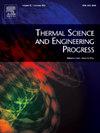Test bench for radiative waste heat recovery in steel mills
IF 5.1
3区 工程技术
Q2 ENERGY & FUELS
引用次数: 0
Abstract
This paper presents the design, manufacturing, and validation of a test bench for a radiation waste heat recovery system, which can reproduce the operating conditions of a real steelmaking factory, in particular, continuous casting. The experimental unit consists of three main components: an emitter, a heat capturing device and a thermal oil loop. The influence of different operating conditions, including emitter surface temperature, thermal oil inlet temperature, and oil mass flow rate, on the performance of the recovery unit was evaluated. Additionally, the impact of the corner effect was studied to determine the effect on the radiation heat transfer. The results showed that the proposed experimental unit can achieve surface temperatures up to 1000 °C, which are like those found in the selected area of the steelmaking process. The temperature of the emitter was found to have a substantial effect on the performance of the heat recovery unit, especially when the temperature is below 800 °C. The oil inlet temperature and mass flow rate were also found to influence the thermal radiation heat transfer rate and the recovery efficiency of the device. The findings reveal the importance of the maximum temperature, oil inlet temperature, and oil mass flow rate for optimizing the waste heat recovery system. This study proposes a valuable experimental methodology for analysing thermal radiant heat recovery units under real conditions, which can be helpful in developing optimized systems to harness waste heat from high-temperature energy-intensive industries, considerably reducing their carbon footprint.
求助全文
约1分钟内获得全文
求助全文
来源期刊

Thermal Science and Engineering Progress
Chemical Engineering-Fluid Flow and Transfer Processes
CiteScore
7.20
自引率
10.40%
发文量
327
审稿时长
41 days
期刊介绍:
Thermal Science and Engineering Progress (TSEP) publishes original, high-quality research articles that span activities ranging from fundamental scientific research and discussion of the more controversial thermodynamic theories, to developments in thermal engineering that are in many instances examples of the way scientists and engineers are addressing the challenges facing a growing population – smart cities and global warming – maximising thermodynamic efficiencies and minimising all heat losses. It is intended that these will be of current relevance and interest to industry, academia and other practitioners. It is evident that many specialised journals in thermal and, to some extent, in fluid disciplines tend to focus on topics that can be classified as fundamental in nature, or are ‘applied’ and near-market. Thermal Science and Engineering Progress will bridge the gap between these two areas, allowing authors to make an easy choice, should they or a journal editor feel that their papers are ‘out of scope’ when considering other journals. The range of topics covered by Thermal Science and Engineering Progress addresses the rapid rate of development being made in thermal transfer processes as they affect traditional fields, and important growth in the topical research areas of aerospace, thermal biological and medical systems, electronics and nano-technologies, renewable energy systems, food production (including agriculture), and the need to minimise man-made thermal impacts on climate change. Review articles on appropriate topics for TSEP are encouraged, although until TSEP is fully established, these will be limited in number. Before submitting such articles, please contact one of the Editors, or a member of the Editorial Advisory Board with an outline of your proposal and your expertise in the area of your review.
 求助内容:
求助内容: 应助结果提醒方式:
应助结果提醒方式:


